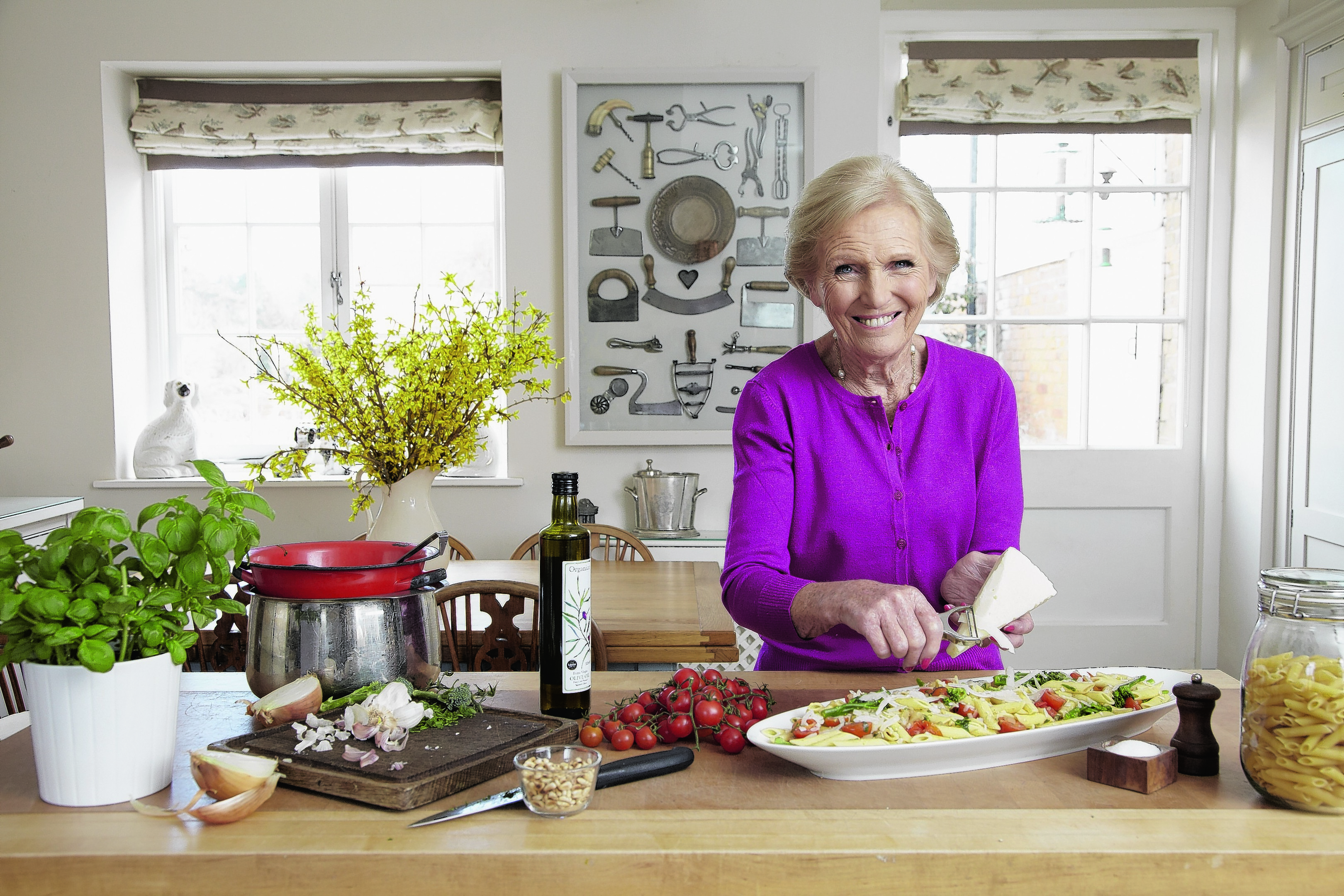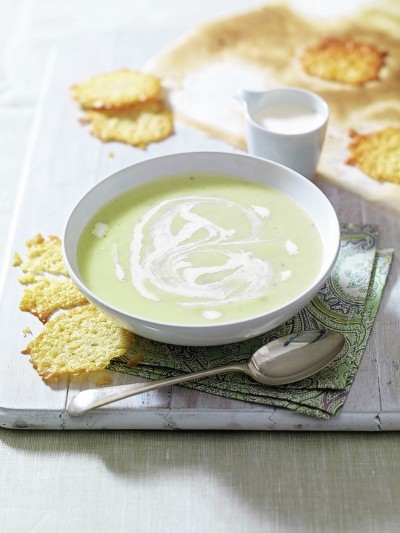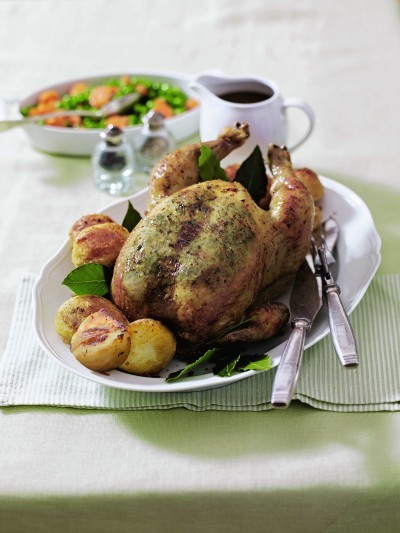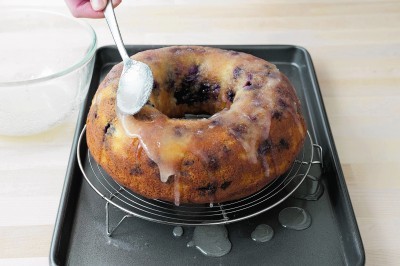Mary Berry isn’t just a fabulous baker, she’s a national treasure and brilliant all-round cook.
Her new book, Mary Berry Cooks the Perfect features more than 100 exciting new recipes, from quick family suppers to impressive dishes for entertaining.
Here, she cooks the perfect dinner.
DOLCELLATE AND LEEK SOUP WITH PARMESAN CRISPS
SERVES 4
This is a rich version of a popular classic – leek and potato soup. The accompanying Parmesan crisps are easy to make and add a special touch for a smart occasion.
600ml (1pt) full-fat or semi-skimmed milk
2 bay leaves
2 springs fresh thyme
Salt and freshly ground black pepper
45g (1
1 large fluffy potato weighing about 300g (10oz), peeled and cut into cubes
2 large leeks, trimmed and finely sliced
400ml (14fl oz) vegetable stock or chicken stock
85g (3oz) Dolcelatte cheese, cut into small cubes
Double cream to serve
PARMESAN CRISPS
MAKES 8
50g (1
Pour the milk into a small pan and add the bay leaves, thyme, nutmeg and a grinding of pepper. Bring just to the boil, until you see tiny bubbles appear around the edge of the pan. Remove from the heat and set aside to infuse for 20 minutes.
While the milk is infusing, make the Parmesan crisps. Preheat the grill to its highest setting. Line a baking sheet with baking parchment. Make 8 circles from the grated Parmesan, each about 6cm (2.5in) in diameter on the baking parchment. Use a round 7.5cm (3in) cutter and place it over each Parmesan circle and spread out so the cheese fills the cutter. Place the baking sheet under the grill and cook for about 4 minutes or until the cheese is melted and pale golden.
Transfer the crisps to a wire rack to cool.
Melt 25g (scant 10z) of the butter in a large pan, add the potato cubes and cook over a very low heat for 5 minutes or until starting to soften but not turn brown.
Increase the heat, add the rest of the butter and the leeks and cook for 3-4 minutes, stirring often, until almost tender. Pour in the stock and strain the infused milk into the pan. Bring the liquid to the boil, then simmer for 8-10 minutes to finish cooking the vegetables.
Using a blender or food processor, puree the soup until smooth. Pour it back into the pan.
Reheat and stir in the cubes of Dolcelatte. Remove from the heat and season to taste. Serve topped with a drizzle of cream, with the Parmesan crisps on the side.
ROAST CHICKEN WITH TARRAGON BUTTER AND ROAST POTATOES
SERVES 4
I do like this way of roasting a chicken: spreading herb butter under the skin makes the meat extra moist and flavourful. While the roasted bird rests, turn up the oven for really crisp potatoes.
60g (2oz) butter (room temperature), plus extra for greasing and the legs
2 garlic cloves, crushed
1tbsp chopped fresh tarragon, plus 3 extra sprigs
Salt and freshly ground black pepper
1.8kg (4lb) whole chicken
1 lemon, halved
1 small red onion, halved and sliced into about 20 small wedges
FOR THE ROAST POTATOES
1kg (2
3 fresh bay leaves, plus extra to garnish
FOR THE GRAVY
1tbsp plain flour
300ml (10fl oz) chicken stock
3tbsp red wine
1tbsp redcurrant jelly
Preheat the oven to 200C (fan 180C/400F/Gas 6).
Lightly grease a large roasting tin with butter.
Make the tarragon butter: put the butter in a small bowl with the garlic and chopped tarragon and beat together with a small wooden spoon. Season with salt and pepper.
Sit the chicken, breast-side up, on a board and remove any string. Gently pull back the skin over the breasts and spread the tarragon butter under the skin over the flesh.
Rub a little plain butter over the legs. Season the outside of the chicken with salt and pepper. Insert the lemon halves and tarragon sprigs in the cavity. Scatter the onion wedges in the centre of the roasting tin and sit the bird, breast-side up, on top. Roast for 50 minutes.
While the chicken is in the oven, put the potatoes in a large pan. Cover with cold water and bring to the boil. Add salt and simmer for 5 minutes, then drain well. Return the potatoes to the pan and gently shake it over a very low heat. Set aside.
After 50 minutes’ roasting, remove the tin, baste the chicken, and put the potatoes in a single layer around the bird.
Tuck the 3 bay leaves among the potatoes. Return the tin to the oven to roast for a further 50 minutes, turning the potatoes halfway through. When the chicken is done, transfer it to a large, warmed serving platter and cover with foil .
Increase the oven temperature to 220C (fan 200C/425F/Gas 7). Transfer the potatoes to a small roasting tin and pour over all but 1tblsp of the top layer of fat from the large roasting tin, leaving all the juices and the onion behind in the large tin.
Baste the potatoes with the fat, so they are coated all over, then return them to the oven to roast for about 10 minutes to get really crisp.
Meanwhile, make the gravy: sit the large roasting tin on the hob. Sprinkle in the flour and whisk. Gradually blend in the stock with the whisk and bring to the boil. Simmer for 2 minutes, then stir in the wine and redcurrant jelly. Stir until thickened. Season and strain into a jug or gravy boat.
Remove the potatoes and sprinkle with salt. Garnish the chicken with bay leaves and serve with the potatoes and gravy.
LIME AND BLUEBERRY RING DRIZZLE
SERVES 24
Fresh limes and juicy blueberries add a lovely flour, colour and texture to this sponge. To get the maximum juice from the limes, microwave them all together for 30-60 seconds before squeezing.
25g (8oz) butter (room temperature) or baking spread (at least 70% fat), plus extra for greasing
225g (8oz) caster sugar
275g (9
1tsp baking powder
4 large eggs
2tbsp full-fat or semi-skimmed milk
Finely grated rind of 3 limes
100g (3
FOR THE GLAZE
6tbsp lime juice (from 3-4 limes)
175g (6oz) granulated sugar
Preheat the oven to 180C (160C/350F/Gas 4). Grease a 1.7 litre (3 pint) ring mould. Cut about 8-10 strips of baking parchment and use these to line the mould.
Place the butter, caster sugar, flour and baking powder in a large bowl. Add the eggs, milk and lime rind and beat using an electric hand whisk for about 2 minutes (or 3 minutes with a wooden spoon) until smooth.
Spoon half the mixture into the ring mould and level it, then scatter the blueberries over the top, keeping them away from the edge of the mould. Spoon the rest of the mixture over the blueberries and spread it evenly with a palette knife to cover the fruit.
Bake for 35-40 minutes or until well risen and the top springs back when lightly pressed. While the cake bakes, make the glaze: Mix the lime juice with the granulated sugar and set aside.
Leave the cake to cool in its tin for a few minutes, then loosen the side with a palette knife. Turn it out onto a wire rack set over a baking tray, and peel off the lining strips.
While the cake is still warm, prick all over with a skewer. Stir the glaze, then spoon it over the warm cake. Leave to cool completely before serving.
- Mary Berry Cooks the Perfect, published by DK, £25, dk.com



